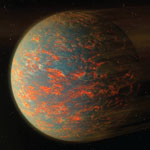From the Vault: Highlight from the Davison Art Center Collection Clare Rogan, Curator
A recent acquisition at the Davison Art Center reveals an engaging intersection of early photography and science, undertaken by a little-known 19th-century Englishwoman. In 1843, only four years after the invention of photography, Anna Atkins started a monumental task, beginning a publication of botanical studies titled British Algae: Cyanotype Impressions. She was using the newly invented technique of cyanotype, best known today as blueprint. This publication was issued in parts from 1843 to 1853 and ultimately included more than 400 plates. It was the first book ever to be illustrated by a photographic technique, and predates William Henry Fox Talbot’s famous Pencil of Nature (1844–1846), in which he demonstrated all the uses of the calotype technique he had invented. After completing British Algae, Atkins continued with her work with cyanotype. The Davison Art Center was delighted to acquire one of the rare and beautiful plates from Atkins’s later album, Cyanotypes of British And Foreign Flowering Plants and Ferns, 1854.
Atkins had first undertaken scientific illustration in 1823, when she meticulously drew more than 250 shells to illustrate a publication of Jean-Baptiste Lamarck’s Genera of Shells, translated by her scientist father, George Children. She must have rapidly grasped the possibilities of the cyanotype process when she learned of it from her neighbor, Sir John Herschel, who invented it in 1842. We can imagine Atkins creating the cyanotypes individually. First she needed to brush paper with a combination of ferric salt and potassium ferricyanide and allow it to dry in a dark room. Her father’s experience as a chemist would have given her ready access to the materials. Then she would place a dried botanical specimen directly on the paper, set a sheet of glass on top to weigh it down, and expose it to sunlight. After exposure, the sheet was washed in water to fix it, and the deep Prussian blue of the cyanotype would become visible. Because no camera or negative was involved, the works are photograms, created by direct contact with the object depicted.
The new acquisition was purchased with funds given in memory of Ellen G. D’Oench ’73, known as “Puffin,” who was curator of the Davison Art Center for 19 years, from 1979 to 1998. It will be on display through May 22 at the Davison Art Center in the exhibition, Collecting Photographs: Ellen G. D’Oench and the Growth of a Collection.


